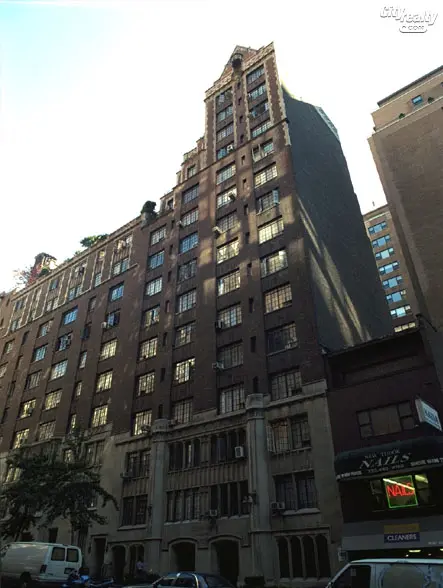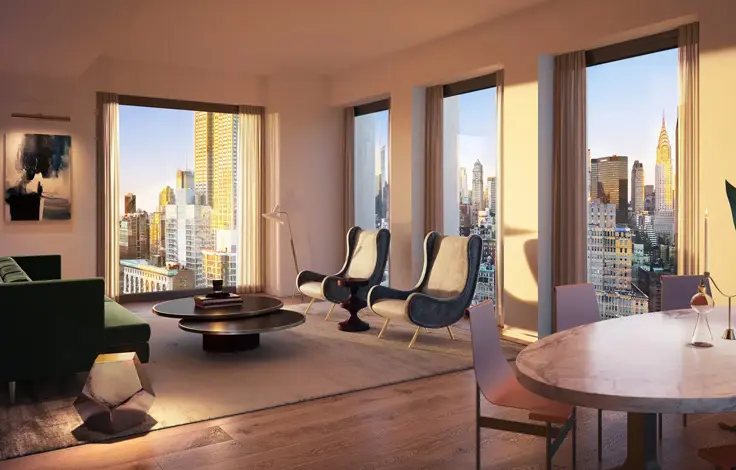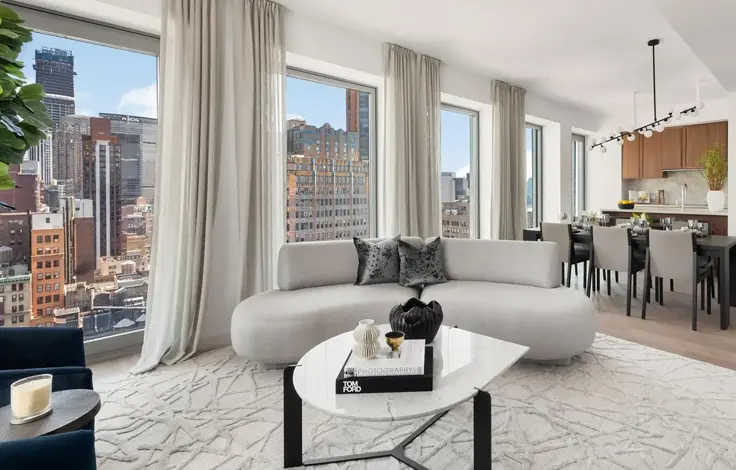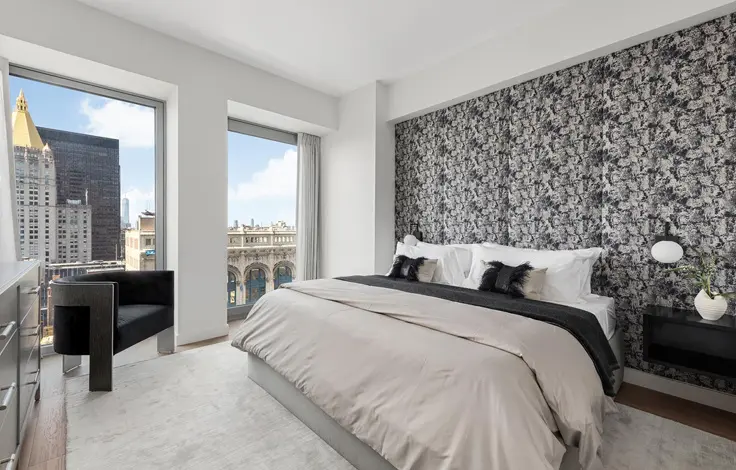Hatfield House, 304 East 41st Street: Review and Ratings
between Second Avenue & Tudor City Place View Full Building Profile


This 15-story cooperative apartment building at 304 East 41st Street is part of the Tudor City complex at the east end of 42nd Street that was erected by the Fred F. French Company.
The building is known at Hatfield House and has 192 apartments.
Tudor City, which consists of 12 buildings and two parks between First and Second Avenue Avenues and 40th and 43rd Streets, an area once known as Prospect Hill, was declared an official New York City landmark in 1988.
The unanimous vote of the Landmarks Preservation Commission described the "city within a city" as "an early and eminently successful attempt to implement the principles of Garden City planning in a high-density urban environment."
The commission s designation maintained that "Tudor City is much more than an assemblage of significant buildings in a 'medieval' style." An article by David W. Dunlap in The New York Times May 15, 1988, said that the complex's structures were "rather simple brick apartment buildings to which an exuberant profusion of limestone ornament was applied top and bottom - the Tudor rose and heraldic arms, portcullises, griffins and boar's heads," adding that "Between the decorative elements, otherwise simple walls were animated by multiple-pane casement windows and expanses of leaded and stained glass, many contained within complex and delicate traceries."
Harry B. Helmsley, one of the city's major real estate figures, owned the complex for a while and planned to replace the private parks with two more apartment towers, generating a major local controversy. Eventually, he scrapped his plans and in 1985 the complex was bought by a partnership of Francis J. Greenburger of Times Equities and Philip Pilevsky of Philips International.
The original complex had almost 3,000 apartments and was erected between 1926 and 1930.
"That Tudor City has been emulated in later developments across the country," the landmark designation report declared, "is testimony to its importance. As a model for apartment building complexes with a distinct 'sense of place,' Tudor city inspired Knickerbocker Village, built by the French Company and the Reconstruction Finance Corporation, as well as First Houses and Harlem River Houses, both designated New York City landmarks, and Battery Park City."
"The urban renewal venture of Tudor City," it continued, "was the enterprise of the Fred F. French Company, an organization infused with the enthusiasm of its clever and diligent founder. The project was conceived in 1925, financed by the company's revolutionary stock-issue plan, and designed by staff architects under the supervision of H. Douglas Ives. The assemblage of property, accomplished in a very short time, was the largest site amassed in Manhattan until that time."
"Predating French's development and standing in the middle of the assembled property," the report continued, "was the six-story Prospect Hill Apartment building of 1925 designed with a Tudor entrance. This structure is also included in the historic district. To this building French added ten residential structures, designed as apartment hotels, apartment buildings and a transient hotel. Except for the latter, all were designed in the Tudor Revival style, which had been popularized in suburban residences and then adapted for urban multiple dwellings....Set off from the New York grid by a change of land grade from the flat midtown streets to the slope of Prospect Hill, it is also distinguished by a central landscaped core and by Tudor City Place, a private street partially lined by shops and other services available to the white-collar tenants for whom the project was built. Tudor City is remarkable for its generous provision of light and air, and for its efficient and attractive apartments. This original phase of construction was complete by 1932."
"In 1954-45 the French company constructed another residential unit, Tudor City Gardens, which is not in the Tudor design vocabulary, but is included in the historic district as a subsequent product of the influential Fred F. French Company. Also included in the historic district and standing on Prospect Hill since 1871 is the Presbyterian Church of the Covenant, designed by J. C. Cady. Cady later gained prominence as the architect of such significant commissions as the Metropolitan Opera House and the Romanesque wing of the American Museum of natural History....But for the most part, Prospect Hill had been a neighborhood of rowhouses; the four surviving houses are included in the historic district....They were designed by two different architectural offices, the prominent firm of Hubert & Pirsson and the prolific architect, John Sexton."
"The way of life French advertised was enhanced by the tulip gardens, a small golf course, and the private parks to accommodate quiet recreation. The public parks, created when East 42nd Street was widened by the city in the 1950s, now serve as extensions of the original open spaces....From the mid-seventeenth century on, the area of Manhattan's East Side encircling the future site of Tudor city was carved into country estates by prominent families: the Kips, De Voors, Beekmans, Brevoorts, and Winthrops....By the time of the civil War, the other estates were replaced by more modest housing. Most infamous of these were the Prospect Hill shanties inhabited by Irish squatters, a group oppressed by the notorious Paddy Corcoran and his 'Rag Gang.' Legend locates the gang's stronghold, 'Corcoran's Roost' on the site of present-day prospect Tower. During the 1870s and 1980s, the land was developed into uniform rows of houses for middle-class residents.....Due to the erection of the Elevated Railway lines on Second and Third Avenues in the late 18790s and the slightly later industrialization of the East River shoreline, middle-class families abandoned their rowhouses which were converted into rooming houses or replaced by tenements bracketed to the west of by the noisy Elevated Railroad and to the east by noxious abbatoirs, meat-packing house, gas works, and a glue factory, the area which would become Tudor City had, by 1900, became a slum inhabited by ethically diverse immigrants."
The building of the United Nations, of course, substantially upgraded the neighborhood. The east façades of the easternmost buildings in the Tudor City complex are mostly blank because when they were built the view was of the stinking slaughterhouses to the east that were eventually replaced by the United Nations, which is one of the world's greatest architectural enclaves.
Haddon Hall, Hardwick Hall and Hatfield at 324, 324 and 304 East 41st Street, respectively, "were named for three of the finest Elizabethan country homes in England - Haddon Hall in Derbyshire, Hardwick Hall, also in Derbyshire, and Hatfield House in Hertfordshire."
"Hurricanes hardly ever happen," as they say....
The designation report of Tudor City notes that "Haddon Hall (eleven stories tall) contains forty-three four-and five-room apartments; three penthouses with terraces are situated at the top. Hardwicke Hall (also eleven stories tall) contains sixty-two apartments of one, three, four and five rooms; there are three penthouses with roof gardens. The Hatfield House (fifteen stories tall) is an apartment hotel with eighty-seven apartments, most of them single rooms. The buildings share a three-story limestone base with quatrefoils and Gothic hoods. All three have their original casement windows and decorated brick spandrel panels with Tudor motifs. Haddon hall has an intricately carved entrance arch, a pair of wooden doors with colored glass insets, and its original lamps. The original doors, glass, hardware, and lamps also are extant at Hardwicke Hall. Hatfield House is capped by stacked pavilions one with a Tudor niche, another with an oriel and tall chimney. The entrance to this building is recessed within a porch with a tile floor. The metal revolving door frame and the ceiling of the porch are detailed with Tudor ornament; the lobby windows are decorated with stained glass. A parapet with quatrefoil band ties the three buildings together as do the crenellation and quoining of the uppermost features."
Fred Fillmore French's mother was a niece of President Millard Fillmore and his father was an "impoverished cigar maker." The future developer won the Pulitzer Scholarship to Horace Mann High School and then attended Princeton University for a year before heading to Mexico for a "taste of ranching."
The report noted that "when French returned to New York in 1905, he became interested in building, and enrolled in an engineering course at Columbia University....Fred F. French formed his namesake company in 1910 when he was twenty-seven. As president, he drew a fifteen-dollar weekly salary, with one small boy as his workforce. Beginning as a humble contractor in the basement of his Bronx home, French soon purchased it (his first acquisition) and rapidly went on to prove himself a financial genius. Despite betrayal by his first partner, French recovered and within a decade of his company's founding obtained a $250,000 loan. He used the money to construct a sixteen-story office building on the northwest corner of Eat 41st Street and Madison Avenue, several floors of which French occupied upon its completion in March, 1920. Barely five years later, he purchased the East 45th Street site for new corporate headquarters. Vastly larger than his Madison Avenue building, more costly and more lavish by far, it testified unequivocally to his meteoric rise."
"At the core of this extraordinary success," according to the report, "was the 'French Plan' which Fred French created in 1921. An innovative form of co-investment by the French Company and its tenants/owners, the Plan was based on 'making a small profit on a large business as opposed to large profits on a small business.' French explained the concept as follows: It is our belief that the people whose money helped to make such building enterprises possible should receiving addition to safety, a fair share of the profits earned. Accordingly, it was decided that the entire net profits from the operation of a building should be devoted towards repaying the investors, together with 6 percent cumulative dividends, before any distribution of such projects could be made to the Fred F. French Companies. Thereafter, by equal division of the common stock, the public receives half the profits in perpetuity.' Unlike the more common cooperative investment plans, the French plan turned over land to its investors at actual cost without padding construction or real estate expenses....Prior to 1925-26, the French plan had been restricted to residential properties, including apartment houses at 15, 156, 17 and 55 Park Avenue, 34 East 51st Street, 247 West 75th Street, 22 West 77th Street, and buildings on Fifth Avenue. The latter were apartment houses at numbers 1010, 1140 and 1160."
The area directly south of the United Nations was occupied for a very long time by Con Edison and subsequently was purchased by Sheldon H. Solow and the Fisher Brothers. Solow subsequently bought out the Fisher Brothers' interest and eventually got city approval to change the zoning to permit the development of several major residential towers and one commercial tower. His architects for the ambitious development were David Smith of Skimore, Owings & Merrill and Richard Meier and the tallest building in the complex has been designed to be taller than the United Nations Secretariat Building much to the consternation of local community and preservation activists. Solow cleared the properties but the financial crisis of 2008 delayed his building plans.





 6sqft delivers the latest on real estate, architecture, and design, straight from New York City.
6sqft delivers the latest on real estate, architecture, and design, straight from New York City.
